Terri Been was sleep starved. She’d been spending 18 hours a day at her computer, contacting as many Texas state representatives as possible, pleading for help. She’d gotten good at hiding the fact that she was an “emotional basket case,” a term she used to describe herself. But her inner turmoil had manifested itself on her exterior. Once a trim high school athlete and coach, the 43-year-old had been stress eating, and was now seriously overweight.
She’d been trying for years to gain control of an uncontrollable situation, and time was running out. Terri Been had exactly one month left to save her brother’s life.

In May of 2016, the state of Texas had scheduled an execution date for her 42-year-old brother, Jeff Wood, and Terri was counting the days until it was time to count the hours. On August 24th, 2016, Jeff was to be transported from the Allan B. Polunsky Unit in Livingston, Texas, to the “death house” in Huntsville, where he was to be killed by lethal injection.
Terri had organized a rally in front of the Governor’s Mansion in Austin. In triple-digit late-July heat, she was rushing around with petitions and pens and clipboards. She had brought a cooler with water and folding chairs for her aging father and stepmother. A friend had made T-shirts that showed a photo of her brother, but, like a bad omen, part of Jeff’s head had gotten cropped off.
Terri spoke with a flat affect, as if that might prevent her from drowning in a torrent of emotion. She had erected a scaffolding of pragmatism around herself that kept her from collapsing.
The mansion’s curtains were drawn, and it was hard to tell whether Governor Greg Abbott was home—and harder still to discern whether he had any concern about Texas’ death row inmates, who numbered close to 240 at the time, let alone their families. The rationale behind the capital punishment system in Texas is nearly impossible to unravel and shrouded in secrecy. People who commit comparable crimes are not treated equally. Poor people and African Americans are at higher risk of being given a death sentence. Meanwhile, according to the Death Penalty Information Center, 160 death row inmates have been exonerated nationwide since 1973. Exhaustive investigations have suggested that Texas may have executed several innocent people since the 1980s. Yet since Abbott took office, he and the Board of Pardons and Paroles haven’t granted a single death row inmate clemency.

There is nothing normal about counting the days until the state kills your brother. Your world shifts in ways you didn’t believe possible. There is always guilt, shame, and pain. And there is always something that makes the execution seem unmerited, whether it is the defendant’s abuse as a child, his mental illness, or the fact that he wasn’t in the room when the murder took place. The sum of those things, in Jeff Wood’s case, is particularly troubling.
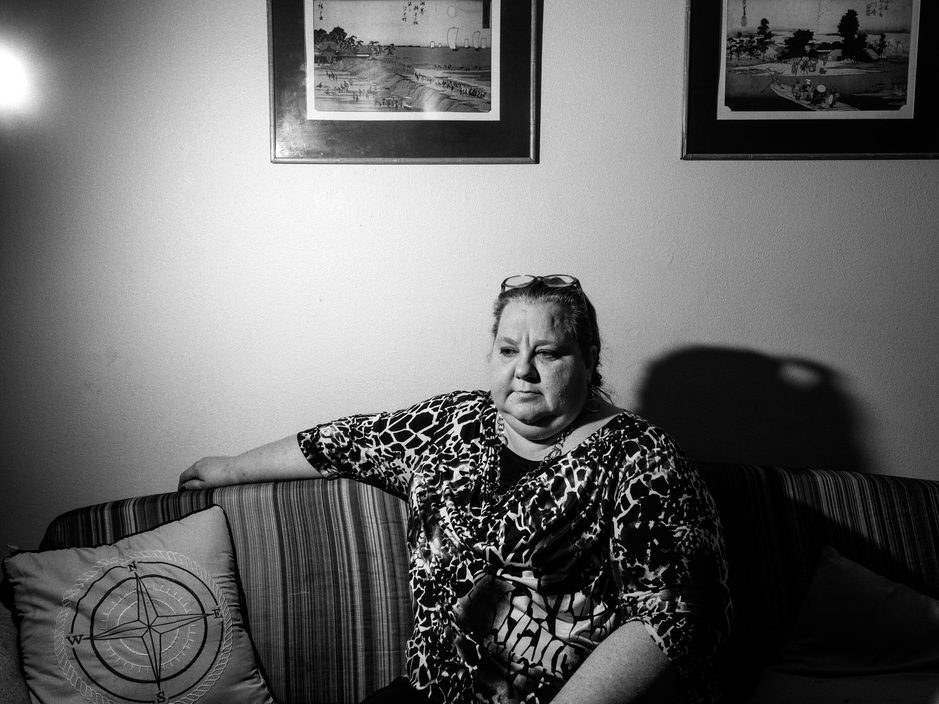
(Photo: Jerome Sessini/Magnum Photos)
Terri’s kid brother has always been special. Down by the river where he would fish and swim as a teenager, Jeff entertained his friends by conjuring up wild fantasy stories. He has always had a hard time drawing the line between fact and fiction. He was just “happy-go-lucky,” his father says. But the good-looking blond-haired athlete had a long-established learning disability and an IQ in the 80s. Jeff never felt like he was good enough, and he thrived on attention. He didn’t seem capable of understanding that some of his so-called friends just used him, that he was often the butt of the joke. Even as he grew into an adult, he kept running to his older sister when something went wrong. “Terri, deal with it!” he would plead. And Terri, who was Jeff’s advocate long before he went to prison, usually would.
Jeff had only known Daniel Reneau, a homeless drifter, for a couple of months, but he was enamored with his new friend’s arrogant bravado. “Jeff was his little stool pigeon,” Terri’s husband, Steven, remembers. “Daniel bullied everybody at gunpoint. That was Daniel’s thing: ‘Look at me, I got a gun!'” Jeff seemed to hope that some of the respect Daniel garnered would rub off on him. He hung around people who didn’t criticize him, people who he didn’t have to compete with intellectually. Blindly, he followed Daniel into the abyss.
Jeff and Daniel had talked about robbing the Texaco gas station in Kerrville, Texas. The station’s manager, William Bunker, had shown them where the store’s safe and recording equipment were in exchange for a cut of the plunder. But on the appointed day, according to Terri, they did not go through with their plan. The very next day, January 2nd, 1996, the two stopped at the gas station in Kerrville on their way to Devine to visit Jeff’s family. Jeff and his girlfriend Nadia had both witnessed Daniel leaving his gun under the couch in the trailer where he and Jeff lived. But Nadia later testified that, while Jeff was waiting outside, Daniel had picked the gun back up before leaving.
At the gas station, Jeff told Daniel he would go inside and ask for the safe. But when he came back out and said he hadn’t asked for it, Daniel took it upon himself. Jeff waited in the car.
When Jeff heard gunfire, he went back inside and found Kriss Keeran, the attendant, shot dead. Daniel then forced Jeff to drive the two away from the scene. Jeff, who’d been threatened by Daniel before, obliged.
It was quickly established that Daniel had fired the gun, and he was sentenced to death in March of 1997. The following year, Jeff was convicted of murder under the controversial Texas Law of Parties. Passed in 1973, the law states that someone can be held responsible for a crime they did not commit if they had helped plan it, or didn’t try to prevent it when they conceivably could have. Lucy Wilke, the prosecutor in Jeff’s crime, argued that, while he didn’t fire the deadly shot, he should be held equally responsible. Reached by email in July of 2016, Wilke maintained that Jeff was the ringleader of the robbery. (Wilke did not respond to multiple calls from the magazine’s fact-checking department.)
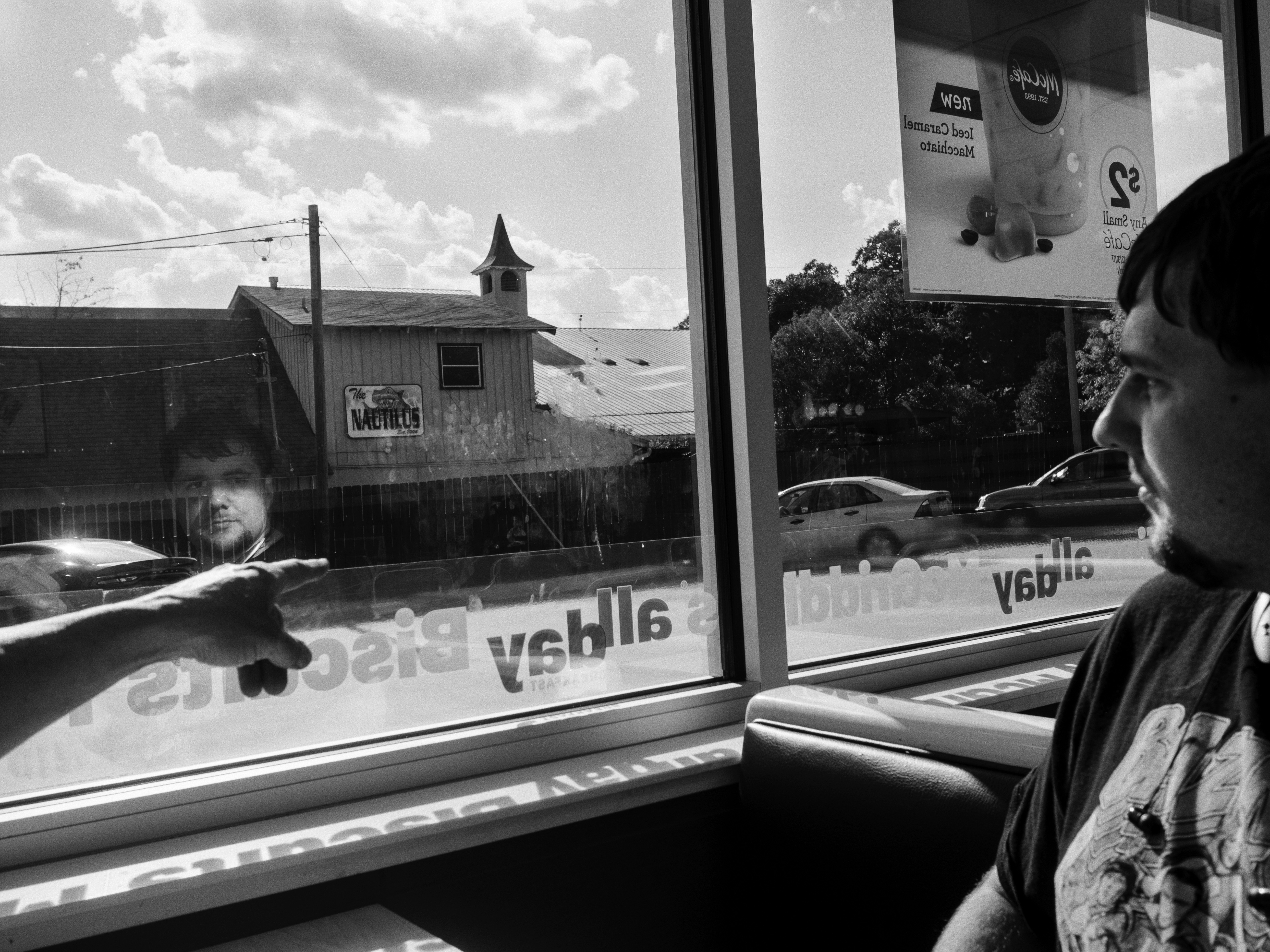
(Photo: Jerome Sessini/Magnum Photos)
In order to sentence a person to death, a Texas jury must unanimously judge that the defendant will commit violence in the future, even though a study by the Texas Defender Service found that expert predictions of a person’s potential to commit future acts of violence are wrong 95 percent of the time. To convince jurors that this would be the case with Jeff, the prosecution hired James Grigson, a disgraced psychiatrist, to testify against him.
Grigson, who has been dubbed Dr. Death because the vast majority of cases in which he has testified have resulted in a death sentence, never even examined Jeff. He solely relied on Lucy Wilke’s version of the story. At the time of Jeff’s trial, Dr. Death had been expelled from both the American Psychiatric Association and the Texas Society of Psychiatric Physicians for ethical misconduct, but this information never made it to the jurors, who unanimously believed Grigson’s assessment that Jeff would absolutely pose a future threat to society.
Anyone who knows Jeff will tell you that it is hard to imagine him the ringleader of anything. In 1997, a jury found him mentally incompetent to stand trial. After a short time in a mental institution, Jeff was sent back to court and deemed competent enough to stand trial. The week before the trial’s punishment phase, he tried to fire his lawyers. A judge denied his request, but Jeff ordered his lawyers to remain quiet, and essentially ended up representing himself. Mitigating evidence of his learning disabilities, his emotional problems, the abuse he suffered as a child, and Daniel Reneau’s power over him never made it into the courtroom.
The average time a death row inmate in Texas spends awaiting execution is, by the state’s own count, 10.87 years. Daniel Reneau was executed in 2002. Jeff has been in isolation on death row now for almost two decades.

“I was taught to believe in our system, and I did, for 35 years of my life,” Terri told the small crowd gathered at the rally. Her husband Steven stood behind her, his arms crossed assertively. Terri is absolutely ashamed that she was once in favor of the death penalty, she said. “I no longer believe in it because I have seen it fail.”
Terri continued with a string of rhetorical questions that had been keeping her awake at night. “Does taking the life of a killer bring about justice, or does it only continue the cycle of violence? Doesn’t the death penalty make a killer of somebody? Does it matter that ‘they’ get paid to ‘do their job’? Shouldn’t they be charged with capital murder under the murder-for-hire law or, at the very least, under the Law of Parties for accepting money to kill somebody?”
Terri’s questions are seemingly of little interest to the state of Texas, which has killed 545 men and women since 1976, nearly five times more than Virginia and Oklahoma, the states with the second- and third-largest numbers of executions.
In an article published by the United Nations, Walter Long, an appellate attorney in Austin, calls the death penalty “a trauma-organized system”—a phrase he borrowed from Arnon Bentovim, the British child and family psychiatrist who coined it in the 1990s to describe violent cycles of interaction that reach beyond the abused and the abuser into the political and societal realms. Because its effects are so far-reaching, Long argues, the death penalty poses a significant public-health concern.
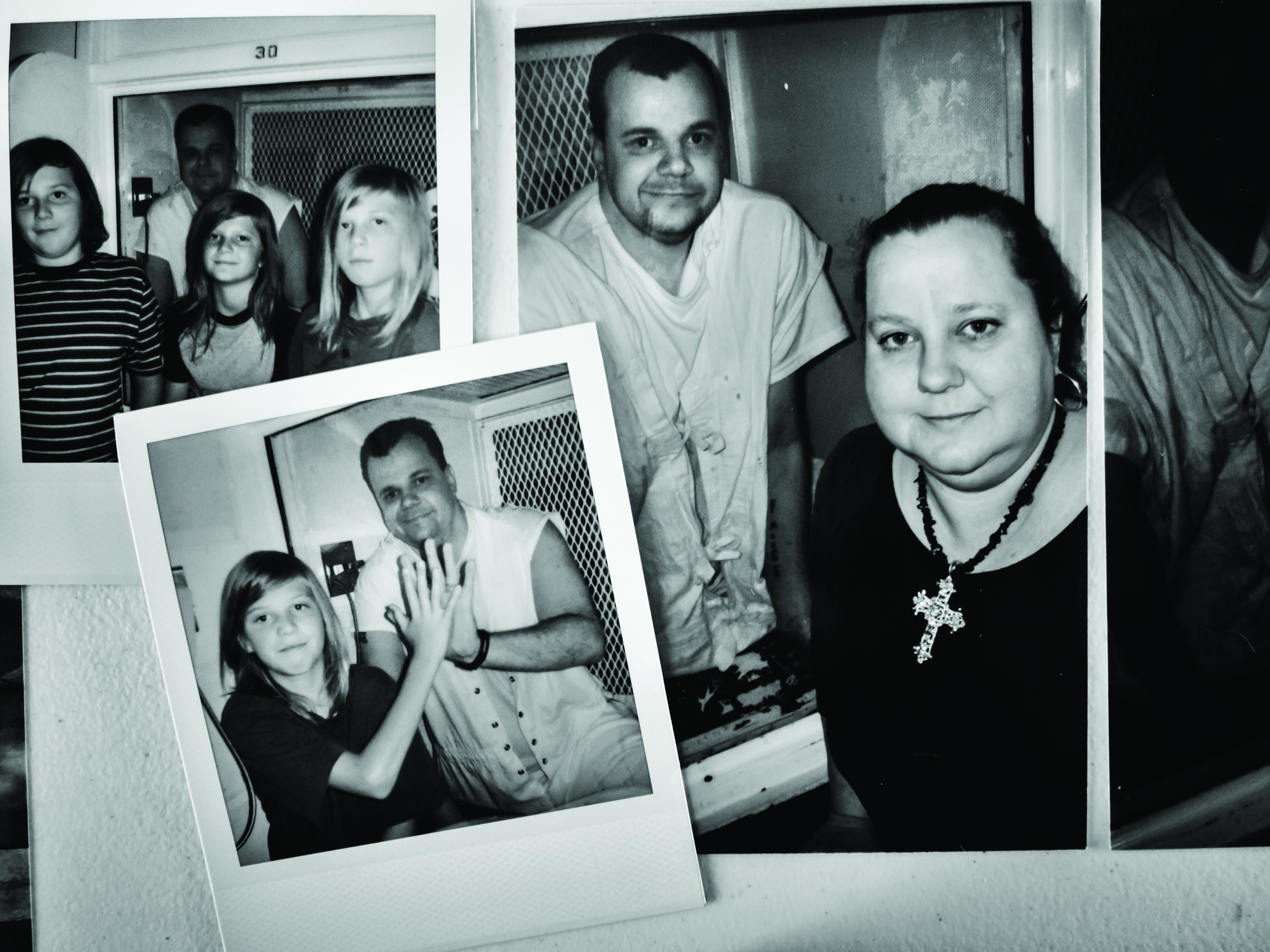
(Photo: Jerome Sessini/Magnum Photos)
“A defendant’s execution is at the end of a chain of terrible circumstances that, in large part, the defendant and his or her family members suffer together,” Long says. “As the overwhelming threat of execution waxes and wanes and then the execution is finally carried out, the process ‘dysregulates’ the defendant’s family in the same way as the defendant. The appeals process moves in fits and starts and can repeat itself, leading to indeterminate anticipatory grief that can be horrible.”
While Terri Been hasn’t herself been convicted of a crime, she may as well have, for all the suffering she has experienced over the past 20 years. The same can be said for the tens of thousands of others who have a loved one on death row in this country. To make the public aware of this ripple effect, Long founded the Texas After Violence Project, a non-profit that promotes non-violent approaches to criminal justice. The organization’s primary activity is to collect testimonies that provide a profound glimpse into the lives of those affected by the death penalty, and to question the far-reaching ideology that punishes violence with more violence. In one video, Jim Willett, a former corrections officer and warden, remembers the effect on his family when he had to carry out five executions in 17 days. In another, Vic Feazell, a former district attorney, recounts why the system has left him wounded. “It’s really, really hard work. Physically and mentally it’s exhausting, whether you’re the prosecutor or the defense. And then it’s a real emotional toll, too, because you are dealing with human life. Not just the life of the person that’s on trial, but you’ve got the victim and then the victim’s family. They think that if this person is put to death then that closes the chapter for them. Well, they all find out it doesn’t. The only thing that ever will close that chapter, from my belief—and this is really hard to talk to the family members of the murder victim about—is forgiveness.”

When I ask her where this story begins, Terri sighs. “My dad, my dad—that’s all I can say. My dad. He was a valedictorian and pushed for perfection,” she says. “We used to get spanked for everything under an 85. Jeff would get it like crazy. He’s always the one that got the worst of it. My dad would just hit him and hit him with a razor strap. We watched Jeff suffer through a lot of physical abuse because he couldn’t remember things. For a long time I tried to break up the spanking, but if you have the adult turn on you, you would sit in the corner and cry for Jeff, and beg him to stop. It had no effect.”
Terri was the oldest of eight siblings and the only girl. She has always been especially protective of Jeff, one of two brothers with whom she shared a mother. “I am my brother’s keeper—that was quoted to me I don’t know how many times. I led him down the wrong path. I’m blamed for everything.”*
Terri wants to forgive her father. She refuses to see herself as a victim. She breaks down crying as she tells me this. I tell her it’s OK to cry.
“I hate looking weak in front of other people,” she says. “It is normal, but that doesn’t take away the guilt and the hate I have for myself. I’m the worst sister ever.”
Terri’s father Danny told me he didn’t beat Jeff because of bad grades, but because of his lies. Jeff was faking his signature on school notes, and tried to cover up for his brothers and sister. Danny sometimes worried that he harmed Jeff’s self-esteem. “How come you don’t catch on?!” he would ask Jeff. “Your brother is two years younger than you—he’s already caught on to this!”
Danny continues to believe in physical—and capital—punishment. Growing up, he was beaten with belts and switches at home, and with boards at school. To him it seemed logical to continue this conduct with his children.
When asked what, in his view, justifies physical punishment, Danny mentions the Bible. “A spanking that don’t hurt don’t teach you anything. That’s one of the things that the Lord put in people and animals. Pain is a teaching mechanism.” Danny thinks the reason why children are “so nuts” today is because parents and teachers are too lenient. “They need to have hall monitors like Steven Seagal or Chuck Norris. They can slap them and knock them down. Period.”

(Photo: Jerome Sessini/Magnum Photos)
Texas is one of 22 states where it is legal for teachers to hit students. “Corporal punishment, now widely recognized as child abuse, persists almost unchecked in the same parts of America where capital punishment thrives,” observes Walter Long. Both practices mirror and sustain each other in places like Texas, spreading the tenets of blame, retribution, and pain into all corners of society.
In a lot of ways Jeff had it better than his father growing up: He was never hungry (Danny often had to subsist on fried potato on old bread); he had a television (Danny had none); he had a father who took him hunting and fishing (Danny’s father never took him anywhere). Danny would even study with him until late at night, yet in the morning, Jeff seemed to have forgotten everything. “It was like if you put a computer off and you didn’t save the information,” Danny told me.
Terri, a middle school science and technology teacher, thinks her brother has a processing disorder. When Jeff was 12, his reading and spelling skills averaged at a third-grade level; his visual-motor integration skills, which describe how well a child’s eyes communicate with his hands, were that of a seven-year-old. A school psychologist described Jeff’s bed-wetting and his self-doubt, his recrimination and fear of embarrassment. “Jeff seems to be struggling between a good, smart and a bad, dumb self-image. There is a drive to please others, but he is unsure how this is done without risk to his emotional self.” He noted that Jeff’s excessive fear led to faulty reasoning and reality testing, and that his hygiene and grooming were often poor. Jeff was fidgety. “He seemed to want attention from his math teacher, asking her for help on the testing activity. The observer’s opinion was that Jeff seemed to want to have his teacher all to himself.”
Jeff was categorized as emotionally disturbed and placed in special education. The psychologist advised his teachers to emphasize what is good and right about him. “Corporal punishment is not suggested since this will only make Jeff feel more helpless,” the report reads.
When Jeff was 15, a different psychologist wrote: “During both test sessions Jeff chewed gum so vigorously that his ears wiggled. His facial and body movements were loose. Sometimes he mumbled or distorted his speech. Jeff was anxious about his test performance and frequently he asked how he was doing. He worded it negatively, though, as, ‘I flunked, didn’t I?’ On the Rorschach, Jeff nervously rotated the cards and took a long time to respond. He was reluctant to risk an initial answer.” After a minute, Jeff asked the examiner, “What do you think it looks like?”
Sadly, Jeff’s story is not exceptional. In 2000, a study of death row inmates in California, published in Social Science & Medicine, found that every one of the 16 inmates examined had experienced violence and individual impairment; 14 individuals suffered from post-traumatic stress disorder (PTSD) and 12 from traumatic brain injury. Violence perpetuates violence. It can sweep through families like a flood.

The entrance to the Polunsky Unit is adorned with a colorful, hand-painted seal that features the state’s proud Lone Star garlanded with lush green olive and oak branches. Below, wobbly lettering reads Death Row. To visitors, it must seem like a mockery—such amateurish signage welcoming them to the place where inmates are kept in isolation for 23 hours a day until they are killed by the state.
The August 24th, 2016, execution date was Jeff’s second. The first had been set for August 21st, 2008. The week before, Jeff’s family traveled four and a half hours to say what they thought would be their final goodbye. As usual, an impenetrable glass wall separated them from Jeff, and they had to talk to him via phone. The first time they would be able to make physical contact with him was once he was dead. While prayer granted them some comfort, eventually everybody broke down. Steven remembered calling his mother. “I was telling her, ‘Momma, I’m trying to be strong, but what if I fall?’ It was too powerful of a situation to make it through unscathed.”
Steven couldn’t bring himself to say goodbye to Jeff. “I said: ‘See you later. We are not leaving each other forever. If they do take your life, I expect you to have golden rope swings and kick-ass waterslides at the river Jordan waiting on me when I get there.'”
Terri refused to leave her little brother, and had to be dragged out of the building by guards, kicking and screaming.

(Photo: Jerome Sessini/Magnum Photos)
Five and a half hours before the appointed time, a federal judge stayed Jeff’s execution, granting him a new competency hearing. Jeff’s offbeat statements during trial and in prison—at some point Jeff had believed himself to be a victim of conspiracy by the Freemasons—”at least arguably suggest petitioner lacks a rational understanding of the causal link between his role in his criminal offense and the reason he has been sentenced to death,” wrote Judge Orlando Garcia.
The reprieve was short-lived. As Terri remembers it, “The very first thing the judge said at the hearing was, ‘What’s the hold-up in this execution?’ I just wanted to jump that little fence that separated us. I wanted to punch him in the face. What are you talking about? That’s my brother!” Jeff’s defense lost the hearing.
In the aftermath of Jeff’s 2008 execution date and subsequent stay, Terri was tormented with numbness by day and nightmares by night. Her dreams kept taking her to the death house. “Sometimes I go in and I watch it happen. And sometimes I can’t and I’m just too frozen with fear. Sometimes it takes me back to the place where I’m saying my final goodbye to him and they are pulling me out of the prison.”

A crime doesn’t happen in a vacuum. It cannot be isolated from larger forces and relationships, whether within families or the culture at large. That’s why a proper trial includes a mitigation specialist, whose responsibility it is to exhume a family’s secrets and try to explain to the judge and jury what led to the perfect storm.
“There is always a trauma history in one form or another,” explained Dana Cook, co-director of the Atlantic Center for Capital Representation in Philadelphia. As a mitigation specialist, Cook has spent 14 years unearthing mitigating evidence for capital defendants.
“When we set out to buy a house, we look at the neighborhood and the school district because we want to make an educated decision. I think it’s natural to say that we should do the same when we decide if a person should live or die. The goal of mitigation is not to sweep the crime under the rug but to help the jury understand how something like this might have happened.” Cook added that proper mitigation doesn’t only involve the negative aspects of the offender’s life. A father’s caring love, his contributions to his child’s upbringing, should also be considered.
There was no mitigation specialist on Jeff’s defense team, and since Jeff basically represented himself, there was no one to even tell the judge and jury about his learning disability, his beatings, his fear, and his inferiority complex. What prevailed was the prosecution’s image of Jeff as a calculating criminal. Nobody heard anything about how much he cared for his daughter Paige.
Paige was only two when her father went to prison. At 22, she is the spitting image of Jeff. Father and daughter have the same round face, the same childlike features, and the same impish smile. While we talked via Skype, she lay on her belly in her trailer while her husband played with their two small sons. Paige has had to work two, sometimes three jobs in order to support her family.
“I have always been a daddy’s girl,” she told me. When Paige was little she used to hide under the counter in the prison’s visiting room. Suddenly, she’d leap up to surprise Jeff. She has pictures of herself with her father from before he went to prison, but no memories of touching or hugging him. Still, she said, he did “the whole daddy thing: ‘Finish school. Don’t have sex. And when you do, be protected.'”
“He doesn’t skip a beat,” she said. “Even though he’s behind glass he’s still my dad.” To say goodbye after visits at the prison, father and daughter align their hands on the glass partition, “touching.”

(Photo: Jerome Sessini/Magnum Photos)
Terri, who helped raise Paige, worries about her. Like her aunt, Paige tries to bury her emotional turmoil, stress-eating and apologizing when tears escape her eyes. She was bullied in high school, Terri tells me. “‘Your dad is a killer, your dad is a monster, your dad rapes small children!’ Even though he didn’t, adults say crazy things and kids pick up on it,” Terri says.
To Elizabeth Beck, a professor of social work at Georgia State University and co-author of In the Shadow of Death: Restorative Justice and Death Row Families, the monster metaphor is destructive. In the mind of the public, Beck says, “by extension, you as a family member are either a monster or you’ve been part of a monstrous situation—or you love or care deeply about a monster. You become not credible, not worthy, and, as a result, you are alienated.”
This bias isn’t always out in the open; it can be subconscious—and even trauma experts aren’t entirely free of its sway. When Susannah Sheffer, the author of Fighting for Their Lives: Inside the Experience of Capital Defense Attorneys, tells colleagues about the effects of the death penalty on families and even attorneys, they often voice surprise. “People aren’t necessarily negative about it, but their first reaction is, ‘I have never even thought about it,'” Sheffer says. “They aren’t only hidden victims, they are also unimagined victims.” To make an informed decision, either for or against the death penalty as a form of punishment, she says, we are obliged to take a public-health perspective, evaluating the impact of the social practice and taking the full data into account.
The problem is, there is little public-health data to begin with. There’s certainly no conclusive evidence that harsh punishment prevents violence, or that it even decreases a state’s murder rate. Analyzing census data from 1990 through 2016, the Death Penalty Information Center found that, from year to year and overall, states with capital punishment had higher murder rates than those that had abolished the death penalty.
According to a 2004 study by Katherine Baicker, now dean of the University of Chicago Harris School of Public Policy, the cost of seeing a case through to a death sentence is estimated to be more than $2 million. Some estimates range as high as $7 million, if you count the time until a person’s execution. “This is as much as 10 times more than a life in prison,” Baicker writes, “and most of these costs accrue at the trial level, contrary to much public discourse about the cost of ‘endless appeals.'” Counties are sometimes forced to increase sales or property taxes to pay for capital punishment trials. For example, to pay for the trial of the white supremacists who killed James Byrd Jr. in 1998, Jasper County, Texas, reportedly increased property taxes by 6.7 percent.
The psychological toll of capital punishment is harder to compute. It is widely assumed that the death penalty, with its implied vengeance and finality, brings closure to the families of murder victims. But this assumption appears to be wrong. In 2012, Marilyn Armour, a social work professor at the University of Texas, co-authored a study that compares the experience of murder victims’ families in Texas with those in Minnesota, a state that abolished the death penalty in 1911. The results are striking. Families of victims in Minnesota reported better well-being and a higher sense of agency than the families of victims in Texas, likely because life sentences have fewer appeals and there is less media coverage and fewer court appearances. As a result, those family members aren’t constantly reminded of the painful details of their loved ones’ deaths. The study participants were less likely to suffer from stress-related conditions like high blood pressure, insomnia, and depression. “You have a lot of people in Texas who, for lengthy periods of time, do not feel the kind of control over their lives that give them a sense of agency,” Armour explains. Instead, she says, “what gets reinforced is impotence and probably anger.”
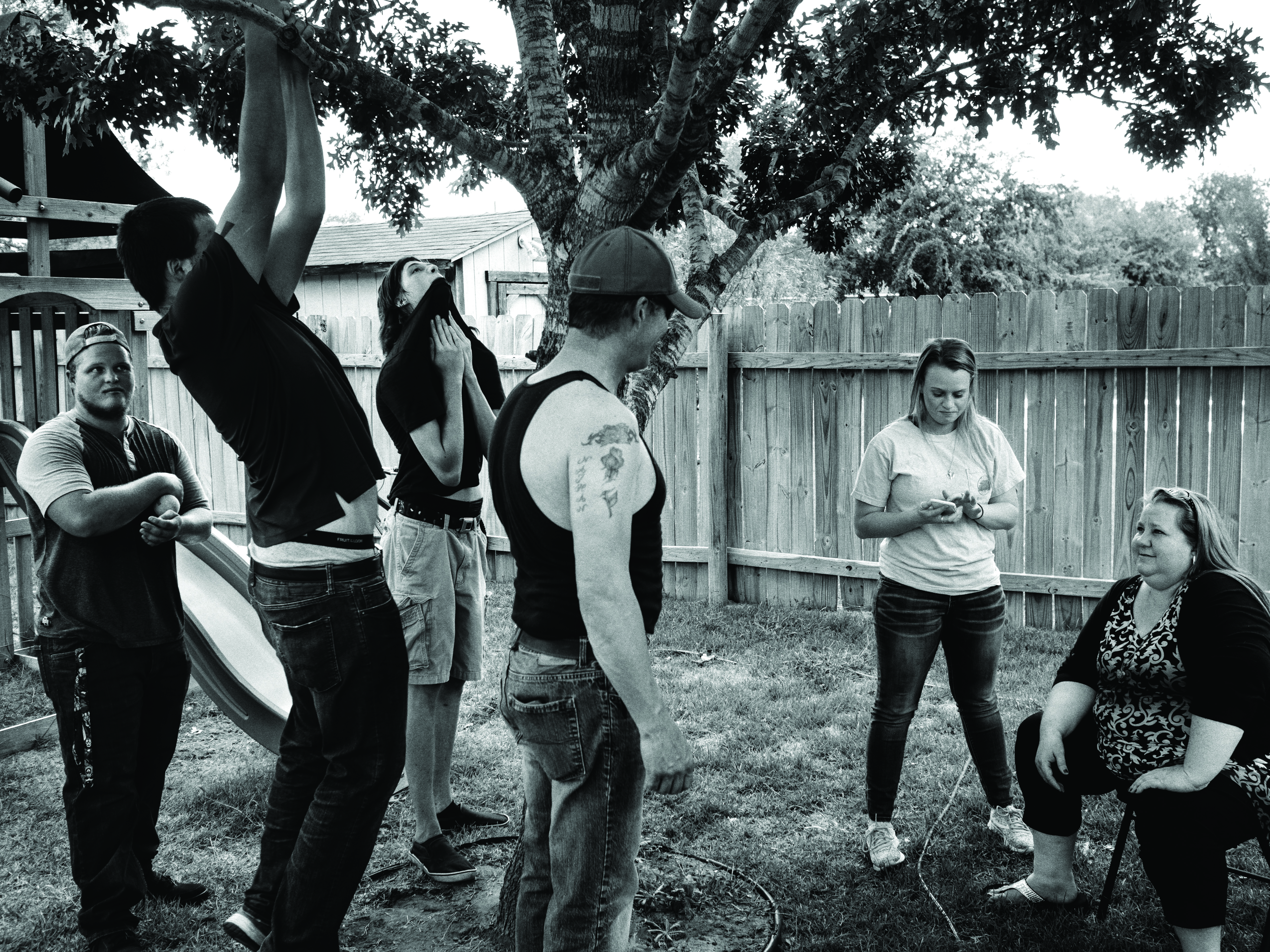
(Photo: Jerome Sessini/Magnum Photos)
It seems logical that the capital punishment system would affect death row families in similar ways. Mitigation specialist Dana Cook remembers accompanying clients to appellate hearings, where they sat alongside the victim’s family, who were, for obvious reasons, angry and in pain. “These emotions tended to come out in the courtroom, and because they couldn’t direct it at the defendant, they directed it at the defendant’s family,” Cook says. Sometimes the victim’s family would just glare at the defendant’s family; at other times things would escalate. “On more than one occasion, sheriffs had to break up potential fights. It was a really traumatic experience for these families who are there to support their loved ones, and next thing they know they are the targets of grief, anger, and hate.”
The pain and adversity isn’t limited to the courtroom. Capital punishment can also pit family members against each other. Except for herself and one brother, Terri says, her entire family continues to support the death penalty. A fight even broke out between them over the subject at her dying grandfather’s bedside.
“When you kill somebody and rape little kids, you need to die,” Danny says. “Terri and I argue a lot,” he admits. “It’s created an atmosphere of hostility in our own household. There’s fighting all the time. We try to skirt around it but it creates hard feelings. It’s gotten to the point where Terri doesn’t even let us know about the rallies. She wants us to speak up against the death penalty, and I can’t. I can only speak up against the Law of Parties; it needs to be taken up on its own merits.”
Families are complicated. Children don’t stop loving their parents because they abused them, and big sisters don’t stop caring for their little brothers because they drove the getaway car. Terri and her husband Steven live with her father and stepmother. They help pay their taxes and utilities. “I love my father,” she says. “But I don’t like him.”

Following the rally in Austin, Terri’s small crowd of supporters gathered at the house of Lily Hughes, a director of the non-profit Campaign to End the Death Penalty. About a dozen of us sat in Lily’s living room and talked over melon and deep-dish pizza. Terri’s four sons, all of them in their late teens and early 20s, kissed their mother before going out to catch Pokémon.
Once the sky darkened and everything quieted down, a brief moment of relaxation set in. Lily put on some music and Terri stretched out on the couch. Anita Ward’s “Ring My Bell” came on, and Terri started singing along. She begged Steven to dance for her. Moments later her phone went off. “Prayers for Jeff!” she called out. Lily turned off the music. Each night at 8:24 p.m. sharp, numbers that mirror Jeff’s execution date, the family stopped whatever they were doing, closed their eyes, and prayed for Jeff’s life. This nightly ritual had become what Walter Long calls an act of “meaning-making,” an attempt to structure and gain agency in a world that has spun out of control.
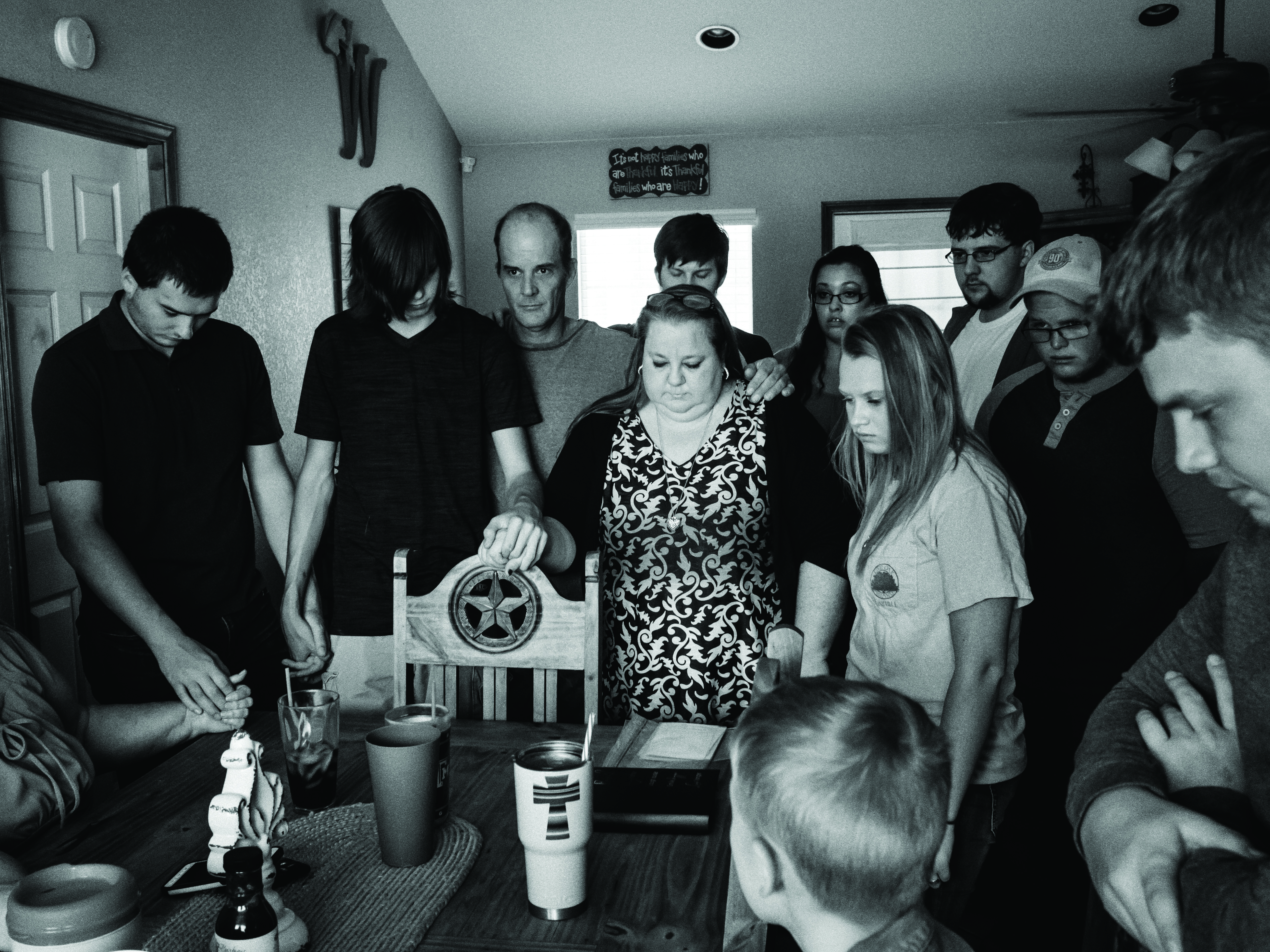
(Photo: Jerome Sessini/Magnum Photos)
During the gathering at Lily’s, Terri’s son Nick occasionally sat down on my armrest to listen in while his older brother Nathan quietly stayed at his mother’s side. With soft features, long, straight hair, and a curious, open nature, Nick appears much younger than his 20 years. One of his skinny arms bears a raised, black fist, a symbol of resistance in the face of violence. The day of the rally, Nick’s skin was still reddened and sore from the needle.
Nick says he used to look forward to visiting his uncle. Upon arrival at the Polunsky Unit, Nick had to take off his belt and shoes and show the bottoms of his feet to the guard. He was patted down for contraband. He didn’t understand why Terri cried, because Jeff always told funny stories. Over and over Jeff would tell the story of when he took Paige to the river when she was a baby and how she peed on him. Jeff didn’t seem to age. In both his speech and emotional affect he appeared like a child, always trying to please and entertain those around him.
During those visits, Jeff would make sure that the kids got their candy first, even though the $40 in coins Terri and Steven brought for the vending machine were barely enough to buy Jeff his few cans of Dr Pepper and the ingredients to his “weird salad,” a concoction of fresh vegetables, Doritos, and hot sauce.
Terri and Steven didn’t have much. Not only did they chip in for Terri’s parents, they also helped support Paige. The gas for the 600 miles from their hometown to Livingston and back cost a fortune. Terri has also been giving Jeff money for pens, toothbrushes, and toothpaste—even for toilet paper.
During family visits to the prison, while the adults talked, the children would run up and down alongside the glass wall. When they would see an inmate sitting by himself, waiting for family or for a guard to take him back to his cell, they’d pick up the phone to say hi. Nick became close with Willie Pondexter, a young prisoner who’d committed murder as a teenager. They became pen pals. “Willie had compassion for the kids,” Steven remembered. “He would make them laugh.”
Reality didn’t set in until the day Nick was told that Willie had been executed. “I sat for four hours with Nick in my lap consoling him because of the tears and the sobbing,” Steven said. “He had lost his friend. That was a big turning point for all the boys, when they realized these people were taken from us.”
When I asked how his feelings had changed since Jeff’s first execution date in 2008, Nick swallowed. “I have stronger, more hateful feelings toward the system now,” he said. “If they take him, by some act of the devil, I’ll know that he’s in a better place. All the memories will probably just flood me when he goes pale.”
Nick has attended multiple rallies for death row inmates and has become accustomed to death penalty supporters driving up to the protesters and flipping them off. One time a guy tried to run Paige and Terri over with his truck. When Paige was 13, someone yelled “Prison whores!” at them. Then there was the guy who would show up to every single rally, yelling, “Kill them all!” One time Nick couldn’t take it anymore. “‘How about I just kill you?’ I yelled at him.” Nick thought the traffic would drown out his voice, but the guy came at him. Then, Nick says, one of his brothers grabbed a fistful of the guy’s hair and threw him on the concrete.
One time in seventh grade, Nick wore his anti-death penalty shirt to school. His teacher challenged him: Surely he was only against the death penalty in certain cases? “I said: ‘No. I’m against it as a whole because when did two wrongs make a right?'” But the God his teacher knew was wrathful and unforgiving. “She was like, ‘It’s been said, ‘An eye for an eye.'” Nick argued that Jesus preached forgiveness, and that times have changed. In antiquity, Nick said, rapists were punished by having their testicles crushed between stones, a method that has long been abandoned, so why not abandon the death penalty? His teacher called on the class president to defend her. Nick decided to let it go, and to keep his mouth shut. “To single me out and to challenge me like that? At the time, that kind of just hurt.”

Until 2005, the death certificate of those executed in Texas listed “homicide” as the cause of death. Now it reads “judicially ordered execution.” In her speech at the rally, Terri called it a form of “state-sanctioned killing.”
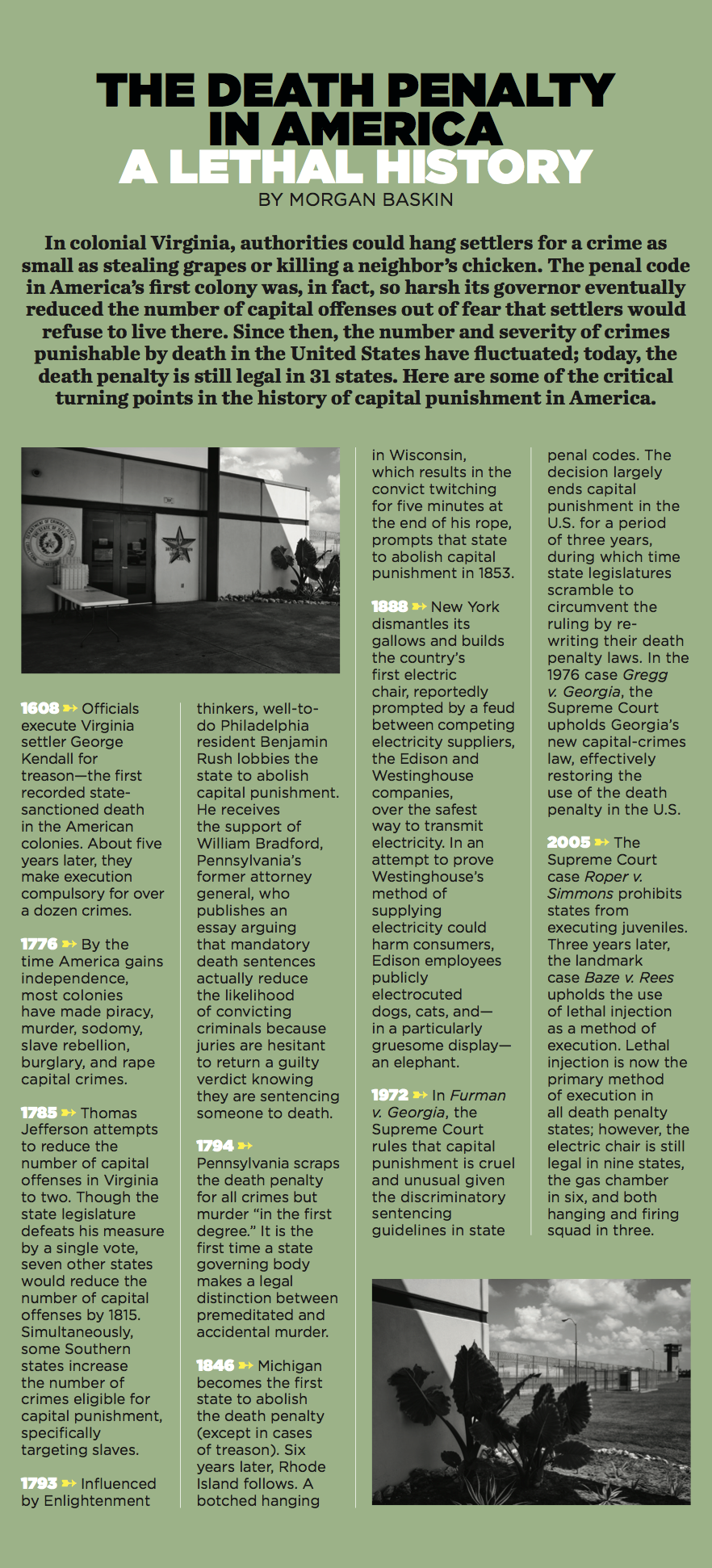
“As opposed to losing someone to death from natural, organic causes, these are family members who have lost their loved ones to the deliberate act of someone else,” says Susannah Sheffer, who has worked on behalf of those who have lost loved ones to violent crime as well as to the death penalty. Comparing the trauma of the two groups, Sheffer has found arresting parallels. Both parties are prone to PTSD, which counts among its key symptoms flashbacks, anxiety, and depression due to the exposure to actual or threatened violent death. The grief of a death row family, however, appears to be even more ambiguous than that of a murder victim’s family. First, there is no individual person to lay blame on; as a killer, the state is more powerful and far-reaching, yet more abstract and opaque. Second, the indefinite looming threat of death complicates the grieving process. If your grief is anticipatory and never-ending, if it isn’t given the chance to run its normal course, if it isn’t acknowledged, validated, or even taken seriously by society, the pain is all the more unbearable.
The social practice of state-sanctioned murder raises a number of troubling questions for Sheffer. “If, as a child, you’re told the state killed your father, what does that do to your relationship with the state? Does that mean everybody is complicit? Or, if a child is told that killing is wrong, why is it OK for the state to kill daddy?”
There is a network of support services for families of homicide victims, but no such thing exists for death row families. When Illinois abolished the death penalty in 2011, money in the Capital Litigation Trust Fund (formerly used for capital defense) was transferred to the Death Penalty Abolition Fund, securing services for families of murder victims and for training law enforcement personnel. The National Organization for Parents of Murdered Children (POMC) possesses a remarkable amount of financial backing as well as dozens of individual chapters across 21 states. POMC holds monthly meetings and provides advocacy and court accompaniment. Nothing like this exists for Jeff’s family.

Terri took time off from school in the summer of 2016 to spend those last remaining days with her brother and, if necessary, to make funeral arrangements. In 2008, during the weeks prior to Jeff’s first execution date, Terri’s former principal had been supportive of her missing work, but by August of 2016 she’d already used up her vacation days. The Family and Medical Leave Act, she discovered, didn’t apply to her situation, and she was worried that the payroll department would penalize her for taking more time off.
Terri didn’t know whether she could watch her brother being murdered. In her nightmares, her “inner demons” forced her to be in the death house, but during her visits with Jeff she couldn’t bring herself to ask him whether he wanted her to be present. She felt like she needed to be there for him and to witness the execution or she would disappoint her little brother yet again.
Instead of talking about his death, Jeff and Terri spoke about where he wanted to be buried. Jeff didn’t want to end up at the Captain Joe Byrd Cemetery, alongside those prisoners whose bodies weren’t claimed by their families. The crosses of death row inmates in Texas don’t even bear names. Some feature prison ID numbers that begin with 999 (a prefix assigned to death row inmates); some of the older crosses are entirely blank. The pariah status of those sentenced to death outlives them.
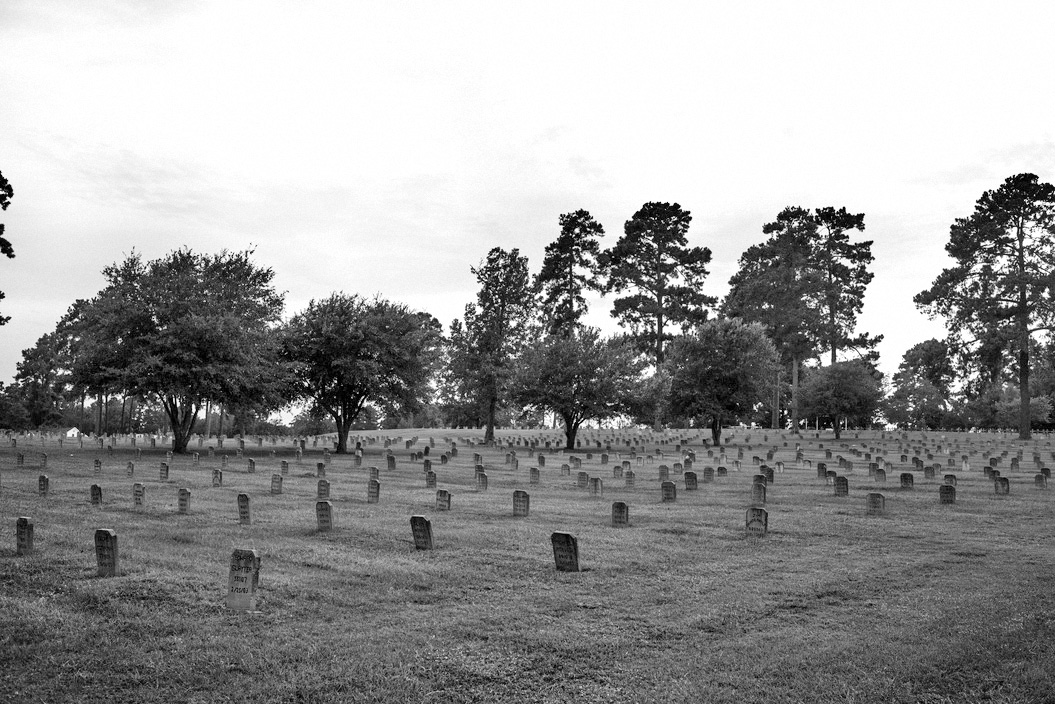
(Photo: Jerome Sessini/Magnum Photos)
During the week leading up to the execution date, Terri’s family began to bicker. Jeff’s official visitation list was limited to 10 adults, and could only be changed every six months. Jeff had put Terri and Paige, their husbands, his parents, his three loyal pen pals, and a “Bible Daddy” on his list. Terri’s boys were disappointed, and Jeff’s six brothers and his birth mother were angry that they wouldn’t be able to say goodbye. As always, Terri remained unflappable: “It’s drama that I don’t need,” she said. She was hurting as well—”it’s beyond depression,” she told me—but she also has an astonishing resilience. She powered through work and sleeplessness, gathering more than 8,000 signatures and getting dozens of Catholic leaders and state officials on her side.
Jeff’s 43rd birthday was on Friday, August 19th, five days before he would be put to death. He was usually allowed one visit per week, but because of his upcoming execution date, he was given extra visitation days; he would be able to see his family and friends on Friday, Saturday, Monday, and Wednesday. The family went back and forth to make a schedule that accommodated everyone as well as possible. On his birthday it was Terri first, then his pen pal Katie, then Paige. But no one felt like celebrating.
Jeff’s lawyer, Jared Tyler, had filed an appeal on July 29th, but the court hadn’t responded yet. Terri felt hopeless. After her morning visit with Jeff, she went to Whataburger to meet family as well as reporters, whose curiosity grew more fervent as the execution date grew near.
That afternoon at five, Terri received a call from Jared Tyler. A criminal appeals judge had stayed Jeff’s execution. The judge merited Tyler’s claims regarding the testimony of the psychiatrist James Grigson. Apparently, three jurors had come forward to say that it would have affected their deliberations had they known that Grigson testified falsely and misleadingly and that he had been expelled from various professional organizations. One juror said he was “angered” that the prosecution put Grigson on the stand. “The government lied to the jury by presenting him as an expert,” the juror said, adding that he no longer believed that Jeff deserved the death penalty.
“We got a stay! We got a stay! We got a stay!” Terri shouted, her face wet with tears. Soon the whole family was laughing and crying, hugging, screaming, and praying. When the flood of emotions subsided, they strategized about how to let Jeff know. He shouldn’t have to wait until visiting hours on Saturday to hear the news. Katie suggested they call in to a radio show Jeff listened to.
And that is how Jeff, on his birthday, found out that he wouldn’t be put to death the following Wednesday.

Katie and Terri’s visit that Saturday was all laughing and goofing around. Terri and Jeff drank soda and had a burping contest, something they used to do when they were children. They could hardly breathe, they were laughing so hard. From behind the glass partition, Jeff participated in the planning of his birthday party, which was to take place that night at Lily’s house in Austin. He had one wish: Take a piece of cake and throw it in his nephews’ faces.
Terri did throw the cake into her sons’ faces, and Katie sent me pictures to prove it. But the photos seem a lot less cheerful when you consider what’s missing: Jeff himself, who cannot attend his own party, and whose right to live is still being debated in the Texas courts. His family continues to fight for his life, while constantly, prematurely mourning his ever-anticipated death.

POSTSCRIPT: While we were preparing this story for press, the Texas Tribune published a letter from Lucy Wilke, the prosecutor in Jeff Wood’s original trial, asking the Texas Board of Pardons and Paroles to recommend that Governor Greg Abbott commute Wood’s sentence to life in prison. The letter was co-signed by Kerrville police chief David Knight, who was an officer at the time of the murder, and Keith Williams, the district judge handling Jeff’s appeal.
*Update—January 16th, 2018: This story has been updated to reflect that Terri shares a mother with a second brother, in addition to Jeff.





